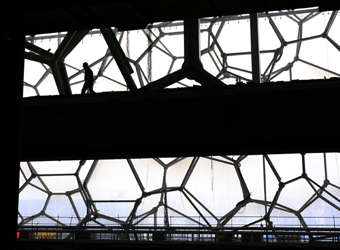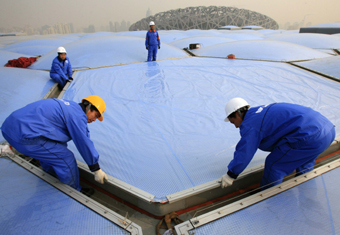The National Aquatics Center, or the "Water Cube," fully represents the
concept of "Green Olympics," in terms of architecture, outside layer
engineering, environmental protection in the areas of material, energy and water
resources as well as the indoor environmental quality, according to a BOCOG
official.

A worker walks inside the National
Aquatics Centre, known as the 'Water Cube', after its plastic film
exterior was completed in Beijing December 26, 2006. The plastic film on
the outside layer of the centre is known locally as the membrane
structure. Swimming, diving, synchronised swimming and the water polo
final will be held in the centre during the 2008 Beijing Olympic
Games.[Reuters]
 |
The project is featured by the
reasonable and efficient application of clean energies, said Yu Xiaoxuan, deputy
director of the Venue and Environment Department of the Beijing Organizing
Committee for the Games of the XXIX Olympiad (BOCOG).
The "Water Cube" absorbs solar radiation and reduces thermal loss, guarantees
the incoming of most of the sunlight which serves as the thermal source of
swimming pool water, Yu said in a recent interview with the press.
The maximum use of natural ventilation and lighting features the
environmental design of the project's outside surface, to ensure temperature and
humidity control in different sections of the swimming pool and provision of
comfortable indoor environment for athletes and spectators, Yu added.

Workers install the last piece of the
National Aquatics Centre's plastic film exterior in Beijing December 26,
2006. The plastic film on the outside layer of the centre, which is also
called the 'Water Cube', is known locally as the membrane structure.
Swimming, diving, synchronised swimming and the water polo final will be
held in the centre during the 2008 Beijing Olympic Games.[Reuters]

|
He said the architects
skillfully took water use into consideration, ensuring the maximum and efficient
utilization and recycle of water and protection of its quality and environment.
The advanced water treatment system enables the water quality to meet the
national standard and the rigid standards of International Amateur Swimming
Federation (FINA) and the World Health Organization (WHO).
According to Yu, guided by the concept of sustainable development,
constructors choose innovative energy-saving materials and products to reduce
inside and outside pollution.
The realization of "green Olympics" in the "Water Cube" project set a good
example for other Olympic venues and the construction of Beijing's urban
projects, Yu believed.
The project uses the state-of-the-art ETFE material which is light but very
strong. The blue bubbles outside the National Aquatics Center comprise over
3,000 air cushions, which look like an entirety but actually they are relatively
independent from each other, providing convenience for replacement of individual
cushions when needed.
The swimming pool is 13 meters deep, which can reduce the interference of
water temperature variation, according to project manager Sun Hongzhuang. The
temperature of swimming pool is projected to be kept at 28 degrees Celsius, the
best suitable for swimmers, Sun said.
During the Olympic Games, the venue can sit 17,000 spectators. "We've made
lots of personalized treatment to let the spectators at every corner to see
athletes' performance," said Sun.